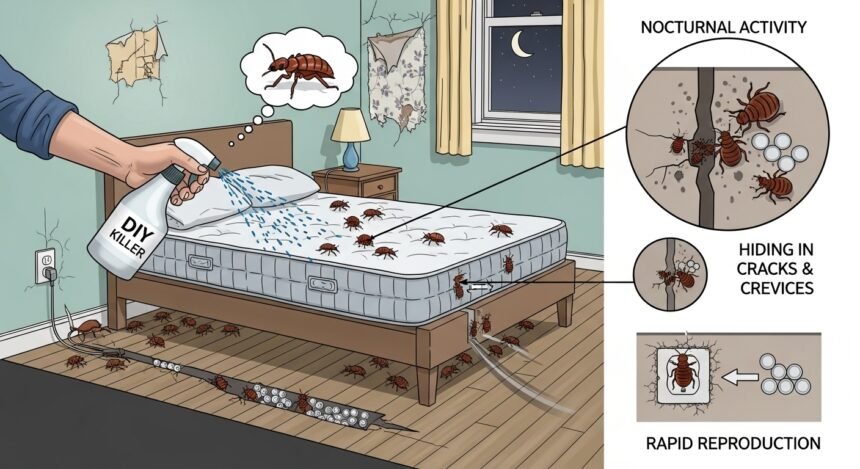Few pests cause as much frustration as bed bugs. They are small, persistent, and difficult to eliminate once they take hold. Many homeowners first try to handle the problem with sprays, powders, or homemade remedies, hoping to stop the bites quickly.
Unfortunately, these attempts often lead to disappointment. Bed bugs are not like other pests. Their biology, hiding behavior, and resilience make them resistant to most over-the-counter treatments. By the time the problem seems resolved, eggs hatch, and the infestation begins again.
This cycle is why professional help is usually necessary. Agile Pest Control emphasizes that understanding bed bug behavior explains why do-it-yourself methods so often fail. Knowing the science behind infestations helps homeowners make better decisions.
Bed Bugs Are Masters of Hiding
One of the biggest challenges with bed bugs is detection. They avoid light, prefer tight spaces, and emerge mostly at night. Early infestations may involve only a few insects, which can hide inside mattress seams, headboards, or behind outlets.
Because of their size and habits, homeowners rarely notice bed bugs until the population has grown. DIY treatments often focus on visible areas, like sheets or bed frames, leaving hidden insects untouched. Even a few survivors can restart the cycle.
They Don’t Stay in Beds
Despite their name, bed bugs are not limited to beds. As populations grow, they spread into nearby furniture, rugs, baseboards, and even adjoining rooms. Without thorough inspection, infestations expand beyond the reach of spot treatments.
An exterminator inspects all potential hiding places, ensuring the problem is mapped out before treatment begins. This comprehensive approach is essential to stop further spread.
Chemical Resistance Is Common
Over the years, bed bugs have developed resistance to many common insecticides, including those found in store-bought sprays. This means that even direct applications may kill only some insects while others survive and reproduce.
This partial effectiveness creates a false sense of success. Homeowners may believe the problem is resolved, only to experience bites again weeks later. Professional pest control uses integrated methods that combine chemical and non-chemical strategies, reducing resistance issues.
Heat and Cold Are Hard to Apply Correctly
Bed bugs can be killed by extreme temperatures, but maintaining consistent heat or cold across an entire space is difficult without professional equipment. Space heaters or hair dryers cannot reach the required temperatures in every corner of a room.
Improper heating may even cause insects to scatter, spreading infestations to new areas. Similarly, freezing items is only effective if temperatures are maintained long enough, something that household freezers rarely achieve.
Professionals use specialized tools to ensure temperatures are both lethal and evenly distributed, something not possible with DIY attempts.
Eggs Make the Problem Persistent
Bed bug eggs are sticky, tiny, and almost invisible. They can cling to fabric, wood, or plastic, often in crevices that homeowners overlook. Even if adults are eliminated, eggs can hatch days later, renewing the infestation.
DIY methods rarely address this stage of the life cycle. Professional treatments include follow-up inspections and reapplications if necessary, ensuring that eggs are destroyed and the cycle is broken.
Cross-Contamination Risks
One of the hidden dangers of DIY approaches is the risk of spreading bed bugs unintentionally. Moving furniture, carrying laundry between rooms, or improperly disposing of vacuum bags can transfer insects to new locations.
Professionals are trained to contain infestations, reducing the chance of cross-contamination. Agile Pest Control stresses that containment is just as important as elimination, since spreading the problem makes treatment more difficult.
The Stress of Misdiagnosis
Bed bug bites vary from person to person. Some individuals develop red, itchy welts, while others show little or no reaction. This inconsistency often causes confusion, leading homeowners to mistake bites for hives, allergies, or other insect activity.
The uncertainty adds to the stress of infestations, with families losing sleep while trying different remedies. A professional bed bugs exterminator in Middletown Township NJ can confirm whether bed bugs are present, providing clarity and direction instead of guesswork.
Prevention Requires Awareness
Most infestations start with bed bugs hitchhiking on luggage, clothing, or secondhand furniture. Hotels, public transportation, and shared spaces are common sources. Preventing reintroduction requires awareness of these risks.
Tips for reducing exposure include inspecting travel bags, avoiding discarded furniture, and sealing items before bringing them inside. While no prevention method is perfect, these habits lower the chances of infestations starting again.
Why Professional Help Works
Bed bug control requires a strategy that addresses every stage of the life cycle and every hiding spot. Professionals combine chemical applications, heat treatments, and follow-up visits to ensure the problem is fully resolved.
Agile Pest Control tailors each treatment to the specific home, considering the extent of the infestation and the unique layout of the property. This personalized approach delivers results that DIY methods cannot match.
Final Thoughts
Bed bugs are persistent pests that adapt to survive. Their ability to hide, resist chemicals, and reproduce quickly makes them especially difficult for homeowners to handle alone. DIY methods may provide temporary relief, but they rarely solve the entire problem.
Professional support ensures that infestations are eliminated completely and that steps are taken to prevent them from returning. Agile Pest Control reminds homeowners that with bed bugs, the most effective solution is knowledge, precision, and timely intervention from an experienced exterminator.







